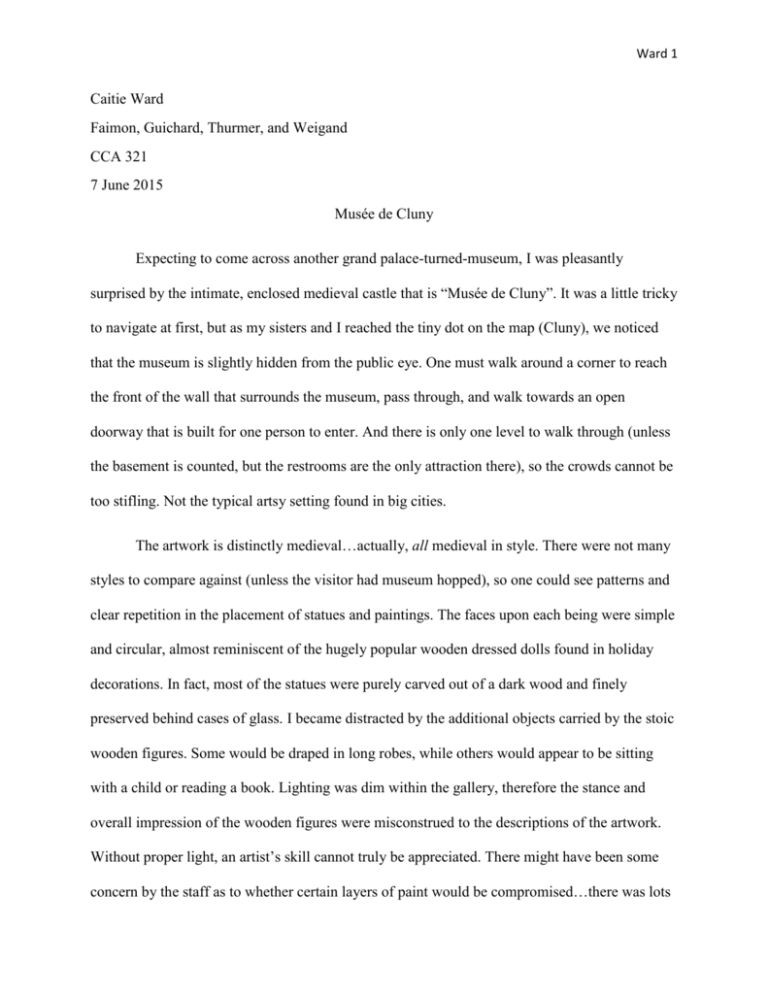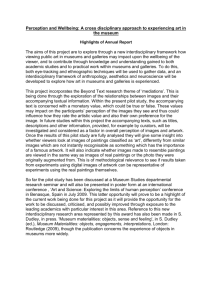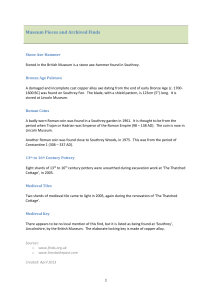Musee de Cluny Reflection – Caitie Ward
advertisement

Ward 1 Caitie Ward Faimon, Guichard, Thurmer, and Weigand CCA 321 7 June 2015 Musée de Cluny Expecting to come across another grand palace-turned-museum, I was pleasantly surprised by the intimate, enclosed medieval castle that is “Musée de Cluny”. It was a little tricky to navigate at first, but as my sisters and I reached the tiny dot on the map (Cluny), we noticed that the museum is slightly hidden from the public eye. One must walk around a corner to reach the front of the wall that surrounds the museum, pass through, and walk towards an open doorway that is built for one person to enter. And there is only one level to walk through (unless the basement is counted, but the restrooms are the only attraction there), so the crowds cannot be too stifling. Not the typical artsy setting found in big cities. The artwork is distinctly medieval…actually, all medieval in style. There were not many styles to compare against (unless the visitor had museum hopped), so one could see patterns and clear repetition in the placement of statues and paintings. The faces upon each being were simple and circular, almost reminiscent of the hugely popular wooden dressed dolls found in holiday decorations. In fact, most of the statues were purely carved out of a dark wood and finely preserved behind cases of glass. I became distracted by the additional objects carried by the stoic wooden figures. Some would be draped in long robes, while others would appear to be sitting with a child or reading a book. Lighting was dim within the gallery, therefore the stance and overall impression of the wooden figures were misconstrued to the descriptions of the artwork. Without proper light, an artist’s skill cannot truly be appreciated. There might have been some concern by the staff as to whether certain layers of paint would be compromised…there was lots Ward 2 of gold seen within biblical depictions on murals. Material for the paintings were typical of works observed in other museums…oil of various shades and what I imagine to be a range of brushes to capture the precise shape and line of the desired effect. There were five rugs showcased in one room that had the theme of “Lady with a Unicorn”. Descriptions of those huge pieces of artwork led visitors to hypothesize the origin or “original intent”. There were various coats of arms on each rug signifying the houses, but the images have puzzled historians. Even though the rugs create a difference in medium of artwork (sculptures, paintings, and wooden figures), the color palette remained the same throughout the whole museum. Warm colors such as brown, red, and yellow remained prominent in every room. There were two rooms of special interest that contrasted with the typical rooms filled with figures. Jewelry and precious collectables were enclosed behind glass walls, creating a surreal effect to a visitor peeking into the room at first glance. With only glass cases on each wall, visitors could stroll from one to the next with ease and wonder. Some of the pieces were beautiful with rare hues of blue in stained glass, while others were slightly gaudy for my tastes (for example, various jewels of the rainbow on one piece of jewelry). The armory was showcased in a room beyond the presentation of seats, and also seen behind glass cases at window-level and across the walls. I could not fully wrap my mind around the fact that actual men had worn the pieces and used the swords that the Cluny currently presented. And wellpreserved at that! The Musée de Cluny is an excellent museum for anyone to enjoy and appreciate, but especially necessary for people with an interest in medieval history. The exclusive collections are unique for its grouping of biblical messages and unified style.







